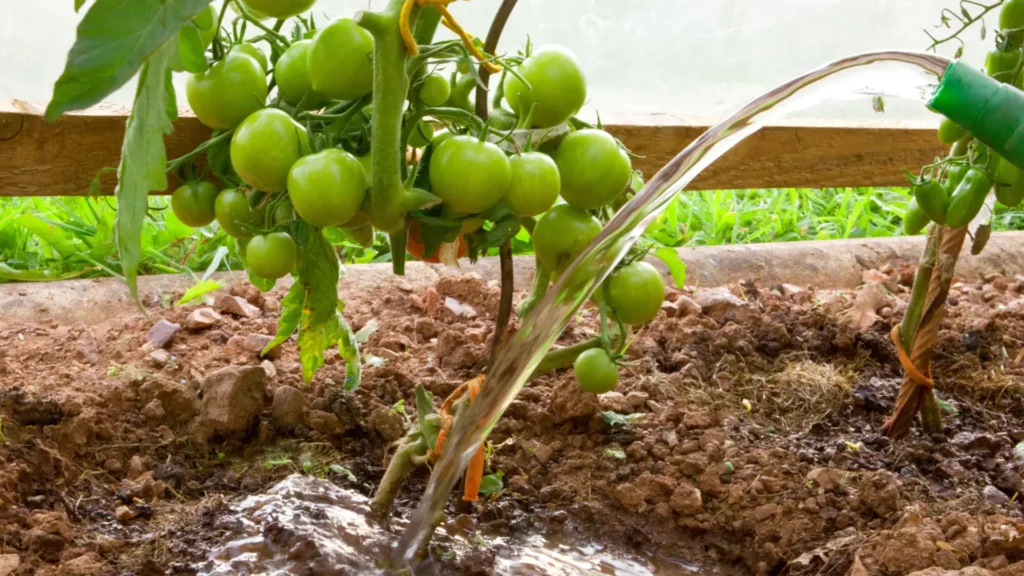Step-by-Step: Preparing the Soil for Tomato Plants

Preparing the soil for tomato plants is the foundation on which successful cultivation is built. It’s the key to unlocking a bountiful harvest and vibrant, healthy plants. But where do you start? How do you ensure your soil has the right balance of nutrients, pH levels, and structure to support thriving tomatoes?
we’ll walk you through a step-by-step guide that covers everything you need to know about preparing the ideal soil for your tomato plants. From understanding soil composition and pH testing to enriching it with organic matter and fertilizers, we’ll empower you with the knowledge and techniques to cultivate the best possible conditions for your tomato plants.
Introduction to Preparing Soil for Tomatoes
Proper soil preparation plays a crucial role in the success of growing healthy and productive tomato plants. By taking the time to prepare the soil before planting, you can provide your tomatoes with the optimal conditions they need to thrive and yield a bountiful harvest.
So why is soil preparation so important for tomato cultivation? Well, tomatoes have specific requirements when it comes to soil pH, texture, and nutrient content. By understanding and addressing these needs, you can create an ideal growing environment for your tomato plants.
When preparing the soil for tomatoes, one of the first steps is to conduct a soil pH test. This will help you determine if the soil acidity is within the appropriate range for tomato plants. Adjusting the pH levels, if necessary, ensures that your tomatoes can effectively absorb nutrients from the soil.
In addition to pH, incorporating organic matter and compost into the soil can significantly improve its fertility and structure. Organic matter helps retain moisture, improves drainage, and provides essential nutrients for vigorous tomato growth.
To further enhance the soil’s nutrient content, consider using organic fertilizers. These slow-release fertilizers provide a steady supply of nutrients to the tomato plants throughout the growing season, promoting healthy growth and fruit development.
Once you have addressed the pH and nutrient levels, it’s time to prepare the soil bed. This involves removing weeds, loosening the soil, and incorporating amendments to improve its structure. Proper soil bed preparation creates an ideal growing environment for the tomato plants’ root systems.
To maintain moisture levels and prevent weed growth, mulching and proper watering techniques are essential. Mulching helps conserve moisture and regulates soil temperature, while adequate watering ensures that the tomato plants receive the right amount of hydration.
Understanding Soil Requirements for Tomatoes
Proper soil preparation is crucial for successful tomato cultivation. Understanding the specific soil requirements of tomatoes is essential to provide them with the ideal growing conditions.
1. pH Level: Tomatoes thrive in slightly acidic soil with a pH range of 6.0 to 6.8. Testing your soil’s pH level will help determine if it needs adjustments for optimal tomato growth.
2. Texture: Tomato plants prefer well-draining soil that allows air and water to penetrate easily. Loamy soil with a balanced mix of sand, silt, and clay is ideal.
3. Nutrient Content: Soil should be rich in organic matter and essential nutrients like nitrogen, phosphorus, and potassium. Adding compost and organic fertilizers promotes soil fertility.
By ensuring that your soil meets these requirements, you’ll provide the optimal environment for your tomato plants to thrive and produce a bountiful harvest. Remember to regularly test and amend your soil to maintain its quality throughout the growing season.
Also read: The Ultimate Guide to Soil Preparation for Your Garden
Conducting Soil pH Testing
To ensure optimal growth and productivity of your tomato plants, it’s crucial to determine if the soil pH is suitable for their needs. Conducting a soil pH test is a simple process that can provide valuable insights into the acidity or alkalinity of your soil.
1. Obtain a soil testing kit from a garden center or online supplier.
2. Follow the instructions provided with the kit to collect a soil sample.
3. Place the soil sample in a clean container and add the testing solution according to the kit’s instructions.
4. Mix the solution and soil thoroughly, allowing it to settle for the recommended amount of time.
5. Compare the color of the solution to the pH scale provided with the kit.
6. Record the pH level of your soil.
Knowing the pH level of your soil will help you determine if it falls within the optimal range for tomato plants, which is typically between 6.0 and 7.0. If the pH level is too low (acidic) or too high (alkaline), adjustments may be necessary to create a more suitable environment for your tomatoes.
Also read: Essential Steps for Preparing Soil for Blueberry Plants
Adjusting Soil pH Levels
Adjusting soil pH levels is crucial for creating an optimal growing environment for tomato plants. Here are a few methods you can use to adjust the pH of your soil:
1. Testing pH: Start by conducting a soil pH test using a pH testing kit or by sending a soil sample to a lab for analysis. This will help you determine the current pH level of your soil.
2. Raising pH: If your soil is too acidic for tomatoes, you can raise the pH by adding amendments such as agricultural lime or wood ash. These materials will neutralize the acidity and bring the pH to a more suitable range.
3. Lowering pH: On the other hand, if your soil is too alkaline, you can lower the pH by adding acidic materials like sulfur or peat moss to the soil. These substances will help to acidify the soil and create a more favorable pH level for tomato plants.
Remember, it’s important to adjust the soil pH before planting your tomato plants to ensure they have the ideal conditions for growth and development.
Also read: The Ultimate Guide to Preparing Soil for Sod Installation
Incorporating Organic Matter and Compost
Adding organic matter and compost to your soil is essential for improving its fertility and structure, which in turn enhances the growth and productivity of your tomato plants. Here are the key benefits of incorporating organic matter and compost:
1. Increased Nutrient Content: Organic matter contains essential nutrients that are gradually released into the soil, providing a steady supply of nourishment for your tomato plants throughout their growth cycle.
2. Improved Soil Structure: Organic matter helps loosen compacted soil, improving its drainage and aeration. This allows the roots to penetrate more easily and access water and nutrients.
3. Enhanced Water Retention: Compost acts as a sponge, retaining moisture in the soil and reducing water runoff. This helps to prevent drought stress and maintain optimal soil moisture levels for your tomatoes.
4. Microbial Activity: Organic matter stimulates the growth of beneficial soil microorganisms, such as bacteria and fungi, which play a vital role in nutrient cycling and overall soil health.
To incorporate organic matter and compost, simply spread a layer of compost over the soil surface and gently work it into the top few inches. Aim to incorporate approximately 1-2 inches of compost for best results. Remember to use high-quality, fully decomposed compost to avoid any potential issues with weed seeds or pathogens.
By enriching your soil with organic matter and compost, you are providing the perfect environment for your tomato plants to thrive and produce a bountiful harvest.
Also read: The Ultimate Guide to Preparing Soil for Grass Seed
Using Organic Fertilizers
Organic fertilizers play a crucial role in providing essential nutrients to tomato plants, promoting healthy growth and maximizing yields. When using organic fertilizers, it’s important to follow these guidelines:
1. Choose quality organic fertilizers: Look for products labeled specifically for tomatoes or vegetables, ensuring they are rich in nutrients such as nitrogen, phosphorus, and potassium.
2. Follow recommended application rates: Read the instructions on the fertilizer packaging to determine the appropriate amounts to use. Overapplication can lead to nutrient imbalances or even damage plants.
3. Apply at the right time: Incorporate organic fertilizers into the soil before planting or during the early stages of growth. This allows the nutrients to be readily available to the plants throughout the growing season.
4. Incorporate into the soil: Mix the organic fertilizer evenly into the soil around the base of the tomato plants. This helps the roots access the nutrients effectively.
5. Consider slow-release options: If available, choose slow-release organic fertilizers. These provide nutrients gradually over an extended period, reducing the risk of nutrient leaching and ensuring a steady supply for the plants.
By following these tips, you can effectively use organic fertilizers to enhance the nutrient content of your tomato plants, resulting in robust growth and a bountiful harvest. Remember to prioritize organic options to maintain the overall health and sustainability of your garden.
Also read: The Ultimate Guide to Fertilizing Soil for Healthy Plant Growth
Preparing the Soil Bed
To ensure the optimal growth and productivity of your tomato plants, it is essential to prepare the soil bed properly. By following these step-by-step instructions, you can create a favorable environment for your tomatoes to thrive.
1. Remove Weeds:
Before preparing the soil bed, start by removing any existing weeds. These unwanted plants can compete with your tomato plants for nutrients and water, hindering their growth. Use a garden fork or hoe to carefully uproot the weeds and ensure a clean bed for your tomatoes.
2. Loosen the Soil:
Next, loosen the soil to improve its structure and allow better root penetration. Use a garden tiller, spade, or garden fork to loosen the top 6-8 inches of soil. This will create a loose and aerated bed, facilitating root development and nutrient absorption.
3. Incorporate Amendments:
To enhance the soil’s fertility and structure, incorporate organic matter such as compost or well-rotted manure. Spread a layer of organic matter over the loosened soil and mix it in thoroughly. This will improve the soil’s ability to retain moisture, nutrients, and beneficial microorganisms.
4. Smooth and Level:
After incorporating amendments, smooth and level the soil bed. Use a rake to create a flat surface, ensuring an even distribution of soil across the planting area.
By following these simple steps, you can create a nutrient-rich and well-aerated soil bed for your tomato plants. This preparation will provide them with a strong foundation for vigorous growth and an abundant harvest.
Also read: The Ultimate Guide to Making Organic Soil for a Healthy Vegetable Garden
Mulching and Watering Techniques
Mulching and proper watering techniques are crucial for maintaining optimal soil moisture levels and preventing weed growth in your tomato garden. Here are some important tips to follow:
Mulching:
– Apply a layer of organic mulch, such as straw or shredded leaves, around the base of the tomato plants.
– Mulching helps retain soil moisture, regulate soil temperature, and reduce weed competition.
– Maintain a layer of mulch that is about 2-3 inches thick, ensuring it does not come into direct contact with the tomato plant stems.
Watering:
– Water tomato plants deeply and consistently, providing approximately 1-1.5 inches of water per week.
– Watering should be done at the base of the plants in the morning, allowing sufficient time for the foliage to dry before evening.
– Avoid overhead watering, as it can increase the risk of diseases, especially on foliage and fruits.
Remember, maintaining adequate soil moisture is key to tomato plant health and productivity. Mulching and proper watering practices will help promote strong root growth, prevent water stress, and ensure a successful harvest of flavorful tomatoes.
Also read: The Ultimate Guide to Preparing Your Garden Soil for the Next Year
Best Practices for Soil Preparation
To ensure optimal growth and productivity of your tomato plants, follow these best practices for soil preparation:
1. Test the soil pH: Conduct a soil pH test to determine if the acidity level is within the ideal range for tomatoes.
2. Adjust pH levels if necessary: If the soil pH is too high or too low, adjust it by adding suitable amendments or organic matter to bring it to the optimal range.
3. Incorporate organic matter: Improve soil fertility and structure by adding organic matter such as compost, well-rotted manure, or leaf mold.
4. Remove weeds: Prior to planting, remove any existing weeds and ensure the soil bed is clear.
5. Loosen the soil: Use a garden fork or tiller to loosen the soil, improving its texture and allowing better root penetration.
6. Add fertilizers: Apply organic fertilizers that are suitable for tomatoes to provide essential nutrients for healthy plant growth.
7. Create a mulch layer: Mulch the soil surface with organic material like straw or wood chips to conserve moisture, suppress weeds, and regulate temperature.
8. Water properly: Water the tomato plants deeply and consistently, ensuring the soil remains evenly moist but not waterlogged.
By following these best practices, you will create an ideal environment for your tomato plants, leading to robust growth and a bountiful harvest.





